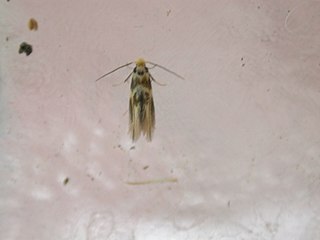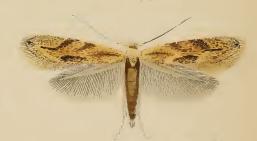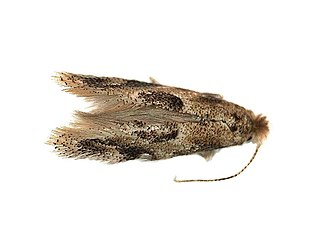
Frass refers loosely to the more or less solid excreta of insects, and to certain other related matter.

Bucculatrix canadensisella, the birch skeletonizer, is a moth of the family Bucculatricidae. The species was first described by Vactor Tousey Chambers in 1875. It is found in North America. In Canada, it has been recorded from New Brunswick to British Columbia, Nova Scotia and Prince Edward Island. In the United States, it has been recorded from New York, New Jersey, Michigan, Wisconsin, Minnesota, Pennsylvania, North Carolina, Tennessee, Kentucky and Colorado.

Bucculatrix frangutella is a moth of the family Bucculatricidae. It was described by Johann August Ephraim Goeze in 1783. It is found in Europe.

Bucculatrix cristatella is a species of moth of the family Bucculatricidae. It is found in most of Europe. It was described in 1839 by Philipp Christoph Zeller.
Bucculatrix thurberiella, the cotton leaf perforator, is a species of moth of the family Bucculatricidae. It was first described by August Busck in 1914. It is native to the south-western United States and northern Mexico. It is an introduced species in Hawaii.

Bucculatrix thoracella, the lime bent-wing, is species of moth in the family Bucculatricidae, and was first described in 1794 by Carl Peter Thunberg as Tinea thoracella. It is found throughout Europe with exception of Ireland and the Balkan Peninsula, and in Japan, where it occurs on the islands of Hokkaido and Honshu.

Bucculatrix ulmella is a moth of the family Bucculatricidae. It is found in most of Europe, except the Iberian Peninsula, Slovenia and Bulgaria. It was first described in 1848 by Philipp Christoph Zeller.

Bucculatrix bechsteinella is a moth of the family Bucculatricidae. It was described by Johann Matthäus Bechstein and Georg Ludwig Scharfenberg in 1805. It is found in most of Europe, except Greece and Bulgaria.

Bucculatrix demaryella is a moth of the family Bucculatricidae. The species was first described by Philogène Auguste Joseph Duponchel in 1840. It is found in most of Europe, Russia and Japan.
Bucculatrix agnella is a species of moth in the family Bucculatricidae. The species was first described by James Brackenridge Clemens in 1860. It is found in North America, where it has been recorded in Pennsylvania, New Jersey, New York, Washington D.C., Massachusetts, Indiana, Tennessee, Kentucky, Michigan, Missouri, South Dakota, Maine, Ohio and Texas.

Bucculatrix ulmifoliae is a moth in the family Bucculatricidae. It was described by Erich Martin Hering in 1931. It is found in Great Britain, the Netherlands, Germany, central and eastern Europe. It has also been recorded from Iran.
Bucculatrix pallidula is a species of moth in the family Bucculatricidae. It is found in North America, where it has been recorded from Maine and Utah. It was described in 1963 by Annette Frances Braun.
Bucculatrix speciosa is a moth in the family Bucculatricidae. It is found in North America, where it has been recorded from Indiana and West Virginia. It was first described in 1963 by Annette Frances Braun.
Bucculatrix arnicella is a species of moth in the family Bucculatricidae. The species was first described in 1925 by Annette Frances Braun. It is found in North America, where it has been recorded from Utah, Montana, Alberta and Wyoming. The habitat consists of open lodgepole pine and Douglas fir forests.
Bucculatrix ceanothiella is a moth in the family Bucculatricidae. The species was first described in 1918 by Annette Frances Braun. It is found in North America, where it has been recorded from California.
Bucculatrix pomifoliella is a moth in the family Bucculatricidae. It was described by James Brackenridge Clemens in 1860 and is found in North America, where it has been recorded from Pennsylvania, Virginia, New Jersey, New York, Massachusetts, Maine, Ontario, Ohio, Tennessee, North Carolina, Missouri, Utah, Washington, British Columbia, Indiana, Manitoba, Quebec and West Virginia.
Bucculatrix armata is a moth in the family Bucculatricidae. It was described by Svetlana Seksjaeva in 1989. It is found in the Russian Far East and Japan (Hokkaido).
Elachista sylvestris is a moth of the family Elachistidae. It is found in the United States, where it has been recorded from Maine, Ohio, Illinois and New Hampshire.
Elachista argentosa is a moth of the family Elachistidae. It is found in the United States, where it has been recorded from Ohio and Maine.






